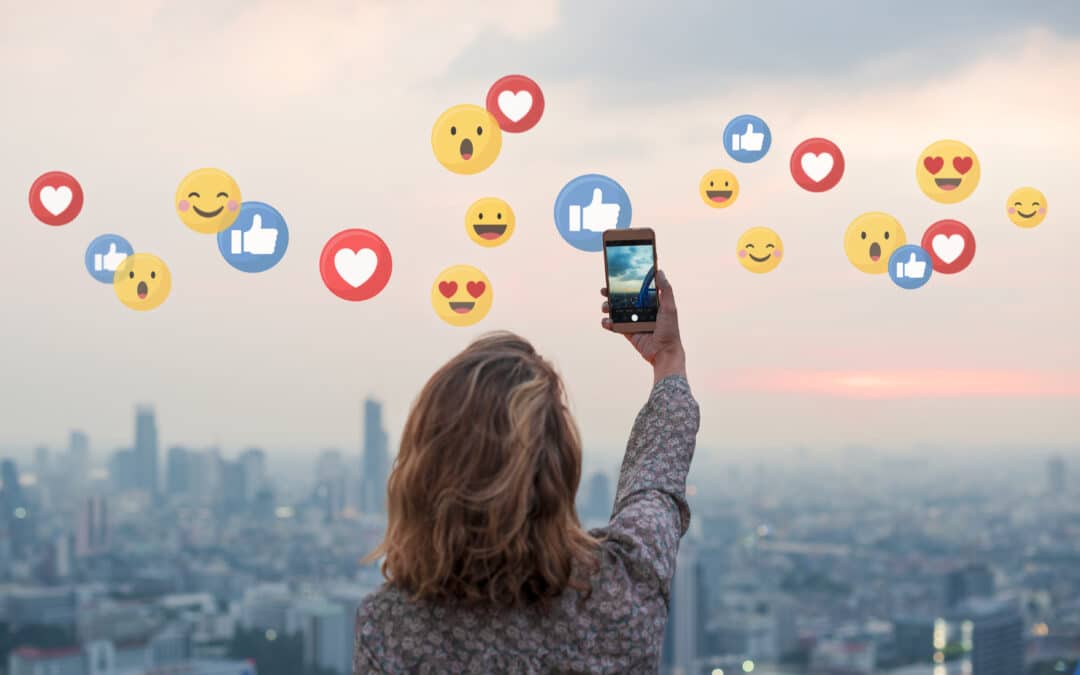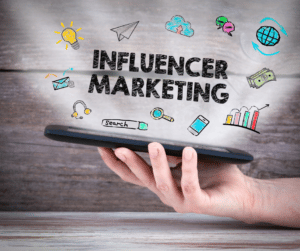User-generated content (UGC) has become a bedrock strategy for marketers everywhere. You’ll begin to understand why it’s helping to amplify social media content when you discover how you can use it to elevate your brand. In fact, many companies aren’t aware that they’re already implementing it through the use of testimonials and reviews. In this blog post we discuss why it’s important to be purposeful with user-generated content, why it’s a great return on investment for advertisers and inspire you to craft your own ideas for informing your audience.
What Is User-Generated Content Marketing?
User-generated content can be defined as any type of content that is created and promoted by fans, employees or consumers, as opposed to a direct promotion by the brand itself. It can include any type of media such as images, videos, social media posts, testimonials and reviews. Many national brands have seen enormous success incorporating this strategy into their marketing plan. Brands are reinventing themselves with the creativity stirred on by their loyal customers. But why exactly is it changing the face of marketing?
User-generated content may sound like a buzzword, but it’s an essential component to determining public perception and for some, longevity. It has been building online communities for years through social media campaigns and is the one thing that brings humanity to a brand, shaking off the corporate messaging that is so often overlooked. User-generated content also gives marketers content where none existed before, all while driving traffic and enhancing engagement. Most importantly, it informs buying decisions. It’s responsible for an increase in conversions and can ensure the survival of a brand.
Why User-Generated Content Is So Effective
Let’s face it, we all know advertisers have a bit of a reputation when it comes to transparency with messaging. Since the dawn of photoshop, rarely do we get a true representation of what a person looks like in real life. Fine lines and other imperfections are typically airbrushed into oblivion. We’ve come to expect this form of trickery in advertising. And for the most part, we kind of expect our advertisers to entertain us, so why not be creative? We know polar bears don’t drink Coca Cola and that a gecko can’t talk (with a British accent no less) about insurance.
This type of advertising, however, is doing more to entertain than inspire confidence in consumer purchases. In fact, two-thirds of consumers say that UGC imbues a more authentic buying experience and that ads in general are somewhat exaggerated. Jim Davidson, director of research at TurnTo Networks claims, “Product reviews, Instagram
photos, unboxing videos — these are unfiltered ways of evaluating an offer that increase shopper confidence.” Based on the data, it’s easy to draw the conclusion that it’s effective because it’s not transactional. People are sharing a genuine experience without expecting anything in return. In today’s world, that speaks volumes.
If we go back a few years, this example underscores the longevity of UGC. Burberry launched a campaign called, Burberry’s Art of The Trench. Knowing that word-of-mouth referrals carry a great deal of leverage, Burberry executed a campaign asking fans to upload photos of themselves wearing their iconic trench coat. Of course, Burberry curated the content, chose their favorite images and showcased it on their Facebook page. The campaign was a massive success. And, when you understand that 86% of millennials rely on social media for purchasing decisions, it’s easy to see why it’s so powerful.
User-Generated Content Influences Buying Decisions
This takes us full circle to the fact that consumers trust real people, not marketers. The shady tactics of advertising executives have left people feeling a little weary. Many products use deception to package a lifestyle rather than a product — beer commercials are notorious for this. People that drink Bud Lite aren’t typically invited to a pool party at a swanky mansion surrounded by supermodels. Chances are, they’re relaxing in their favorite recliner watching sports in their sweatpants.
The idea of the disingenuous marketer has reached new heights. Now more than ever people crave connection and some type of authentic interaction. They also want to see a reflection of who they are, not an idyllic or unattainable version of themselves. An overwhelming 92% of consumers would trust a recommendation from someone they know over branded content. That seems like a significant gap and it’s causing brands to rethink their strategies.
In this blog post, Authenticity In Social Media, written by Three Girls’ Heather Cooper, Heather disseminates what it truly means to be authentic in today’s overwhelming world of social media. Heather offers compelling and supporting evidence to humanize your brand and be genuine with your messaging.
How And Why You Should Incorporate User-Generated Content Into Your Marketing
User-generated content has been around for decades in some form or another. Some of our earliest influencers were popular sports figures who starred in television ads to boost sales. Brut cologne had a successful campaign in the 1970s with Joe Namath. It worked! Brut sales went up because men identified with Joe and desired to be part of that club. It has the unique ability to create a sense of belonging. In a theory written by MacMillon and Chavis in 1986, they determined four things that made people feel like part of a community.
- Membership
- Influence
- Shared emotional connection
- Integration and fulfillment of needs
The shared emotional connection is the primary drive for user-generated content. Here are some methods that companies of any size can implement to humanize their brand.
You can begin a user-generated content strategy by asking your customers for photos interacting with your product or service.
- Ask them for advice on a product name, packaging idea or launch; your customer base is bursting with great ideas.
- Giveaways usually garnish a lot of traction. People love free stuff, and since they’re already following you on social media they will likely be motivated to participate.
- Another way you can be active is by asking for reviews and testimonials. This may seem basic, but reviews have become the lifeblood of savvy shoppers. Online reviews and testimonials are a spoke on the UGC wheel and became a revolution in customer trust when they were first introduced. Their legitimacy has grown exponentially over time.
Word-of-mouth advertising is known as earned advertising in the marketing industry. Add in the ever-growing popularity of social media, sharing this with a global audience just became a lot easier. If you’re tentative or undecided about adding testimonials to your website, check out some of these compelling benefits.
- Brand perception and sales are significantly impacted by reviews from customers. If positive, they can help establish you as a credible and trustworthy business. Even though negative reviews can be used to sway buyers away from your business, they are also an opportunity to show the consumer you care by providing solutions to those issues when possible.
- Testimonials and reviews can serve to widen your scope of business simply by showing potential clients how versatile you are. Giving clients access to reviews gives them an indication of how you’re prepared to meet their needs too.
- Simply put, posting testimonials on your website expedites the buying decision for your customer. When reviews are readily available, it shows a level of transparency that would be difficult to attain otherwise.
- Brands are in a unique position to gain valuable insight into how customers view your product or service. You’ll quickly learn what your audience really thinks about you.
When you create a comprehensive message about your business, provide the persuasive resonance of testimonials and combine it with the functionality and convenience of social media, you’ve identified a winning strategy for promoting your brand.
How Companies Successfully Incorporate User-Generated Content
The cost-effectiveness of UGC can’t be overstated. Brands offer rewards, discounts or the opportunity to be showcased on their website. This can come with tremendous savings, especially if you don’t have the deep pockets of bigger brands. In a way, this form of marketing levels the playing field; companies are only limited by their imagination.
You can begin by incorporating it consistently as part of an ongoing strategy, but consumers do need direction about what content to share and when to share it — and it’s your job to help them. In fact, more than half of consumers wish that companies would guide them about what type of content to share. Here’s where you can step in and create a call to action for your customers. The best time to do this is immediately after the purchase has been made. Here are some examples:
- Costco sends out a review notification within 48 hours of receiving an online purchase. You can also encourage customers to share their review on social media or give them an incentive by way of a discount if they share a video unboxing their purchase.
- Another example of UGC content is when Starbucks rolled out a White Cup Contest where customers were asked to doodle on their cups and post the images to be entered in a competition. Starbucks used the contest to choose a design that would be developed for a limited-edition Starbucks cup. In just three weeks, nearly 4,000 people submitted entries, revealing that people were excited and willing to engage with the brand.
- The Wanderlust Contest from National Geographic was a brilliant campaign to get people spending more time outdoors. In order to enter the contest, users shared their best nature image using the hashtag #WanderlustContest. The winner received an incredible seven-day trip for two exploring Yosemite National Park. The prize aligned nicely with National Geographic’s brand as well as the contest itself.
- Another favorite among outdoor enthusiasts is the GoPro; their breathtaking user-generated content is all over Instagram. The hashtag #GoPro has over 50 million posts, which shows that it’s a terrific way to share your adventures. This outfit specializes in making durable cameras for those who want to document their travels, so it’s natural that they have people sharing epic photos from all around the globe. GoPro uses their product effectively to garner content that resonates with their brand.
- In March 2015, when Apple discovered that customers were dissatisfied with the quality of photos taken in low light, they launched a campaign called, “Shot on iPhone.” The company wanted to regain credibility and focus on what makes an iPhone special, which is its ability to take stunning photos. Although it began as a simple idea, Apple dedicated a lot of importance to the campaign. Pro users were taking photos in low light and posting them on YouTube under “Shot on iPhone” for everyone to see. It was Apple’s intention to select images that would be displayed on over 10,000 billboards around the world. It became one of their most recognizable campaigns. In addition to commissioning artists and photographers, the company also partnered with big name celebrities like Selena Gomez and Lady Gaga to create music videos. However, the user-generated content campaign mainly showcased everyday visuals that can only be captured by the awesome lens of Apple’s iPhone camera.
Remarkably, employee-shared content garners a whopping eight times the attention of content shared by brands. Employees will typically have much higher organic engagement than a corporate account. It turns out customers want to see the faces behind the brand, both employees and customers. The personal brand revolution has taken over. When you’re scrolling through social media and see brands reposting their customers’ content, UGC is an integral part of their strategy – it’s no accident. Photos and video are highly prized when it comes to content; it is by far the most engaging and gets the best results.
Keep in mind that the goal is to inform your customers’ buying decisions, which has a lot more gravitas than uploading pretty pictures to Instagram. These are just a few examples of how you can incentivize your customers to create content. However, depending on your brand, it’s best to come up with specific methods that align with your customer persona.
Choose A Social Network That Aligns With Your Brand
The effect user-generated content has on your brand relies largely on choosing the right social channel. Companies don’t need to have a presence on all social media; it’s ideal to focus on where their customers can be found and making that channel a priority.
Then, you can weigh out adding more channels as your time and resources become available. If your goal is to boost brand awareness, then assign metrics to each channel that deems whether it’s successful. If you’re a clothing brand, chances are you aren’t going to be on LinkedIn, but you’ll do favorably on Instagram. Always test your content to see what’s working and be prepared to change course.
User-generated content is effective because it’s not corporate. As your team develops new strategies they can leverage that same authenticity from previous campaigns to go beyond the original platform and use that content for websites, email and print.
One More Reason UGC Is Effective
We can conclude that the benefits of user-generated content are evident. It’s the secret ingredient to pepper into any marketing campaign. The value proposition, cost-effectiveness, trust, authenticity and the ability to drive conversions makes it a win-win for marketers.
We’re all living in a fast-paced world with a landscape that’s continually changing; content needs to be relevant and on trend. It allows customers to inform the brand on what’s new or the latest industry news. Imagine spending money on an ad campaign and something unexpected happens that makes it old news by the time it airs. When brands are in touch with their audience they can tap into that potential and use it to their advantage. There is compelling evidence that UGC will continue to burn brightly on the marketing stage.
Need Help With Your User-Generated Content Strategy?
If you’re looking for help with your UGC strategy, our team of experienced marketers is here to assist you! We offer a complimentary 30-minute, no-obligation consultation with our CEO, Erika Taylor Montgomery. Contact us to learn more about how we can help you achieve your marketing goals.
Special Offer:
Sign up for a complimentary consultation during December and receive an Annual Marketing Planning Guide valued at $475! We offer a 30-minute phone consultation with our CEO, and can answer your questions and discuss your specific marketing needs - no strings attached. Call 408-218-2391 or contact us today to arrange your consultation!






